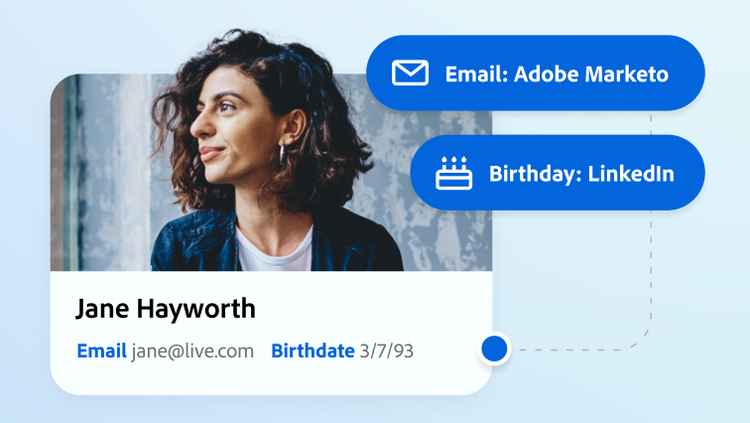ADOBE REAL-TIME CDP FEATURES
Actionable unified customer profiles
A single, unified view of your customer ensures every team member has consistent customer data to improve engagement and deliver the right experiences. With Real-Time CDP, unified customer profiles are updated with data from all sources and ready for real-time activation.
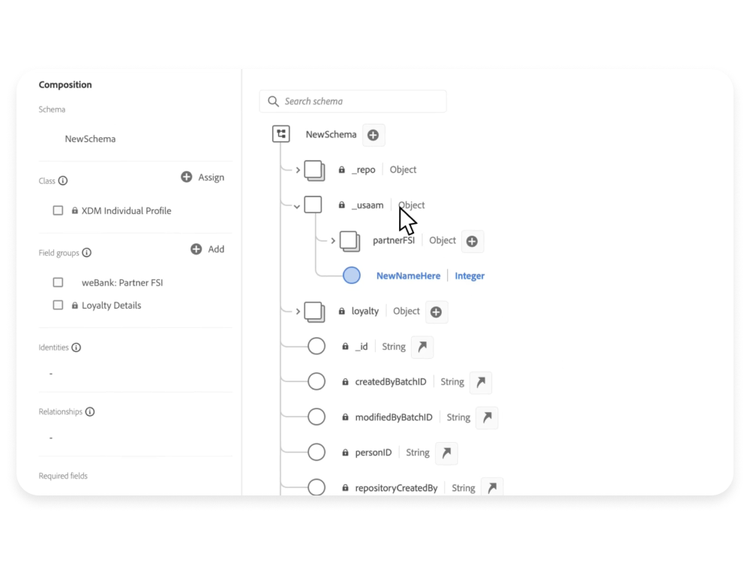
Experience Data Model (XDM)
Standardise how customer data is managed across teams, systems and tools with an industry standard, open-source data model that can be leveraged with B2C and B2B data from any channel.
- Open-source model. Analyse consumer behaviour by tapping into an extensible channel-agnostic data model.
- Interoperability. Apply a thorough understanding of data across all business units to increase consistency between applications.
- Pre-built schemas. Power internal workflows using out-of-the-box B2B and B2C data schemas or customise them to intake insights faster and fulfil your unique and complex enterprise data needs.
Identity service
Gain a comprehensive view of your customer and their behaviour, across devices and systems.
- Identity collection. Ingest identity data, including standard IDs and standard and customised namespaces.
- Graphing. Use a deterministic algorithm to reconcile devices and log ins across customer activity.
- Visualisation and validation. Map relationships between identities and validate identity stitching within a graphical user interface.
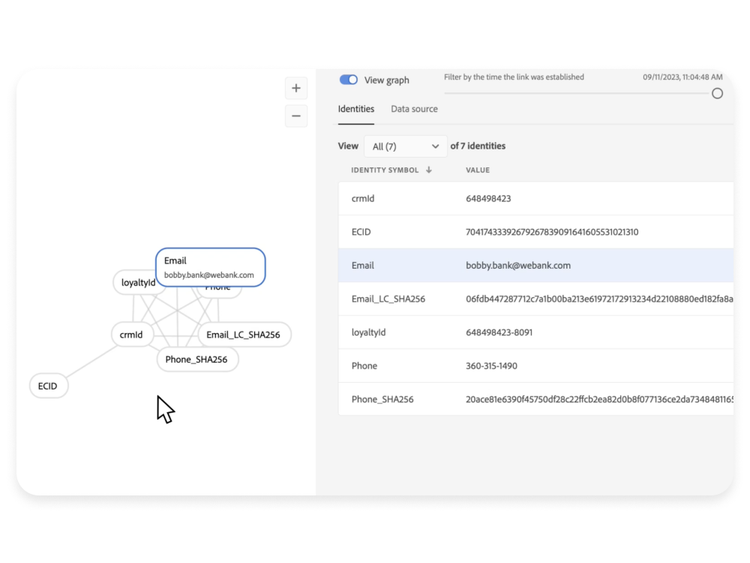
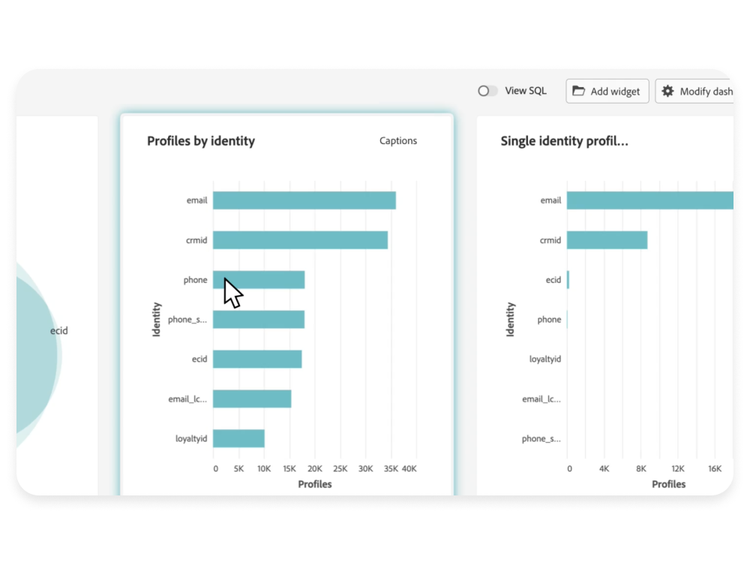
Real-time customer profiles
Establish a consistent customer view into a single customer unified profile from both online and off-line sources. Profile data can be validated by building profile snapshots, metrics and detailed views.
- B2C, B2B and hybrid profiles. Link B2C customer data and B2B account data within a single unified profile that spans audiences and lines of business.
- Real time. Update profiles instantly as customers interact with your brand.
- Validation and dashboarding. Validate and understand profile data through profile snapshots, metrics and detailed views.
- Differentiated data for use cases. Maintain separation between customer and prospect profiles for flexibility in supporting various marketing motions.
Data ingestion
Unify customer data with pre-built connectors, APIs and SDKs for access to disparate data at speed and scale.
- Real-time streaming and batch collection. Stream data in real time to and from Adobe and non-Adobe client- and server-side devices for faster insights, quicker time-to-market and more timely responses to customer engagement.
- Pre-built connections. Choose from dozens of ready-made data sources and destination connectors from our catalogue or easily customise data intake and activation configurations to meet your data management needs.
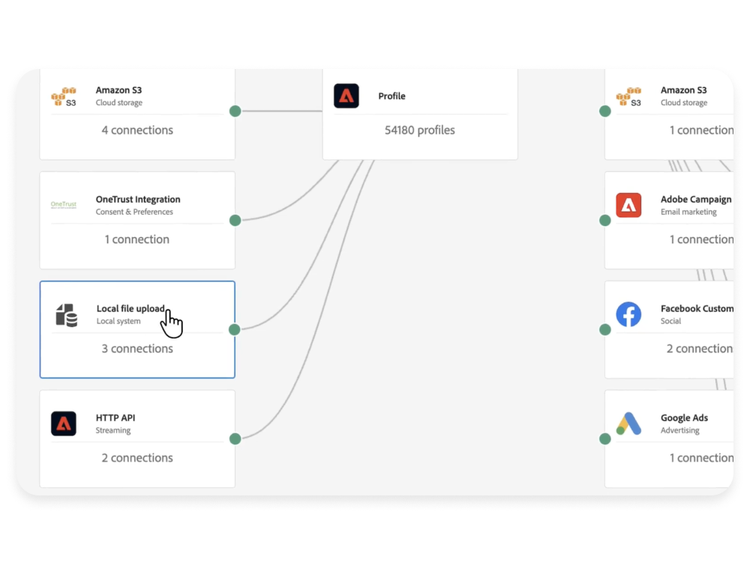
More about actionable unified profiles.

Learn how to use actionable unified profile features.
Adobe Real-Time CDP unifies customer data in real time, enabling personalised experiences across both B2B and B2C contexts. Its AI-powered insights, federated audience composition and use-case playbooks empower marketers to build complete audiences and deliver targeted campaigns efficiently.
Find what you need in Experience League, our vast collection of how-to content — including documentation, tutorials and user guides.
Learn more | Learn more on how to use actionable unified profile features
Questions? We have answers.
1. Demographic profiling.
Demographic profiling is usually the first step in understanding your customer base. It covers basic statistical categories like age, gender, income, education level, occupation and marital status.
While this type of profiling is a great starting point, it only tells part of the story. Just because two users fall within the same age or income category, doesn’t necessarily mean they think, shop or live the same way. That’s where the next layers of profiling come in.
2. Geographic profiling.
Where your customers live can reveal a lot about their preferences and needs. Geographical segments such as country, city, climate or urban vs. rural setting are useful for localising campaigns and understanding regional trends.
For example, a clothing retailer uses geographic profiling to promote winter coats to customers in colder northern regions while advertising lightweight jackets to those in warmer southern areas. This ensures region-specific relevance and boosts campaign effectiveness.
3. Psychographic profiling.
Psychographic profiling looks at user’s attitudes, values, interests, lifestyles and personality traits. What motivates them? What do they care about? What kind of content do they engage with when they’re not shopping? This kind of insight is essential when it comes to creating brand messaging that resonates with your target audience.
For example, a fitness brand targets health-conscious consumers who value sustainability by promoting eco-friendly workout gear. By aligning messaging with customers’ values and lifestyle choices, the brand builds stronger emotional connections and drives loyalty.
4. Behavioural profiling.
Behavioural profiling analyses customer actions such as purchase history, product usage, browsing patterns and brand interactions. It helps predict future behaviour and personalise experiences. By understanding patterns in how people interact with your brand, you can anticipate their needs and identify opportunities to upsell. Behavioural data is especially useful for delivering timely, relevant experiences that feel custom-built for the individual.
For example, an e-commerce site notices that a customer frequently browses running shoes but hasn’t made a purchase. Using behavioural analytics, it sends a personalised email with a discount on running shoes, encouraging conversion based on the customer’s browsing behaviour.
